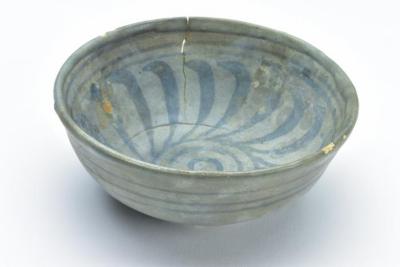Bowl Physical Object
Accession Number
1986.008.0963Category
Creation Date
circa 1620Description
A small majolica bowl from the wreck of the 1622 galleon Nuestra Señora de Atocha is 5 centimeters tall and 11.5 centimeters in diameter. This thin-walled ceramic is of type deemed “Sevilla blue-on-blue” by archaeologists. It is characterized by a light blue glaze that is painted over with a darker blue decorative design.Dimensions
4.7 cm H , Item (Overall)
116.46 g Weight
11.5 cm Diameter
Exhibition Label
Case Caption (2023):HOUSEHOLD CERAMICS
Pottery in all its forms was made throughout South America since pre-historic times. It was often painted or decorated with incised designs, but glazing was unknown. Archaeological evidence indicates that Indigenous potters adopted glazing from European artisans once they learned the process. They also freely adapted European designs for their own ceramics while producing dinnerware and other basic forms useful to the colonists.
Most of the ceramics found on the 1622 fleet were made in Spain. However, in the colonies, Panama became particularly known for its production of majolica (tin-glazed ceramics), and there was also a major pottery in Lima.
Object Caption (2023):
Bowl
Majolica (c.1620)
Gift of Jamestown Inc.
1986.008.0963
Previous Exhibit Case Caption: Removed 2022 WHITEWARE Called Loza Blanca (white ceramics) in shipboard inventories, this plain, tin-glazed majolica represents the most common and cheapest form of tableware at the time. It is usually found as plates, drinking vessels and bowls. This traditional style of earthenware pottery was made in the Seville area, and is derived from the styles utilized by Arab occupiers of the region in the previous centuries. The grayish appearance of many of these examples is a reflection of their submersion in the sea.
